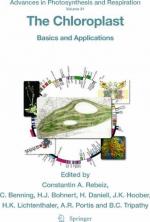|
This section contains 420 words (approx. 2 pages at 300 words per page) |

|
Chloroplasts are organelles—specialized parts of a cell that function in an organ-like fashion. They are found in vascular plants, mosses, liverworts, and algae. Chloroplast organelles are responsible for photosynthesis, the process by which sunlight is absorbed and converted into fixed chemical energy in the form of simple sugars synthesized from carbon dioxide and water.
Chloroplasts are located in the mesophyll, a green tissue area in plant leaves. Four layers or zones define the structure of a chloroplast. The chloroplast is a small lens-shaped organelle that is enclosed by two membranes with a narrow intermembrane space, known as the chloroplast envelope. Raw material and products for photosynthesis enter in and pass out through this double membrane, the first layer of the structure.
Inside the chloroplast envelope is the second layer, which is an area filled with a fluid called stroma. A series of chemical reactions involving enzymes...
|
This section contains 420 words (approx. 2 pages at 300 words per page) |

|


